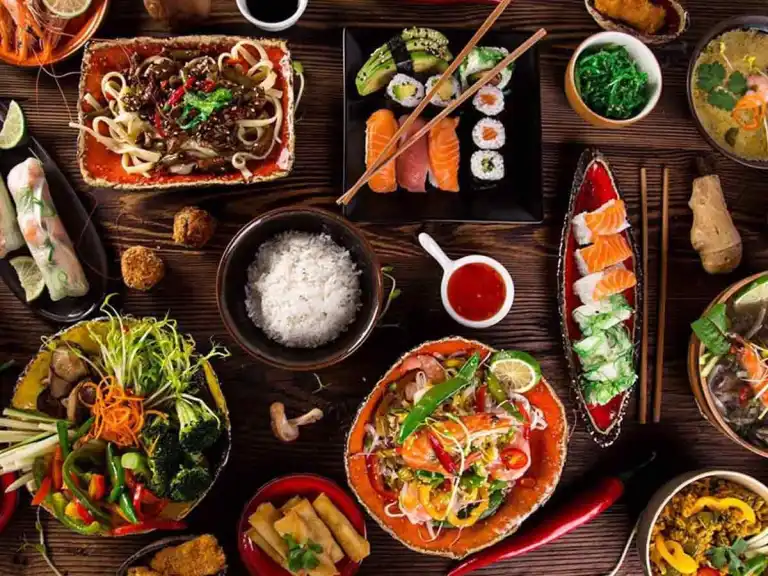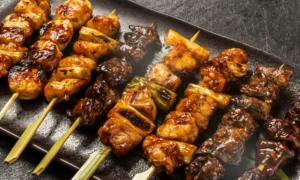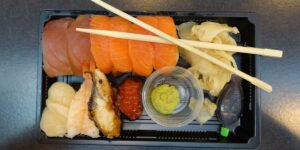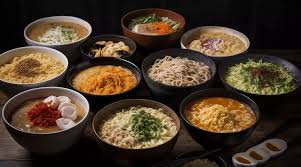Street food in Japan

Most street food vendors use special carts known as yatai, which they move along with Japan’s cultural and festival program. In the country, you can find yatai who work not only collectively on holidays, but also independently on weekdays, but for Japan this is a relative rarity. In many cities of the country, the culture of street food, which is so widespread in many Asian countries, is not developed at all or is poorly developed. Exceptions are, for example, places such as the city of Nakatsu (Nakasu) in Oita Prefecture and the port area of Fukuoka, known for its street food.
Much of the variety of Japanese street food is based on old traditions dating back to the early 20th century or earlier. In many cases, these foods are either not served at all in mainstream restaurants, or are served but taste different from the authentic street original. It’s common for street vendors to offer customers ultra salty, ultra sweet, or ultra spicy snack options.
Okonomiyaki
Okonomiyaki are Japanese specialty savory pancakes. This traditional Japanese dish appeared as a way to use the leftover products that you have at home. The classic dough recipe includes water, flour, eggs and cabbage. During Japanese festivals, matsuri are wrapped in a variety of fillings, including thickly sliced bacon. Okonomiyaki is fried on a special flat hot metal plate called teppan, and sprinkled with dried tuna shavings on top.
Watame
Classic American amusement park snacks such as cotton candy and caramel apple are favorite desserts at Japanese matsuri. Cotton candy carts are usually decorated with images of trendy bands or cartoon characters.
Yaki Imo
A traditional Japanese snack, yaki imo is a wood-fired sweet baked potato. Carts and stalls selling yaki imo equipped with special wood-burning stoves can be found all over Japan. Moreover, sellers can move carts around the city in circles with the loudspeaker turned on: which plays monotonously: “yaki imo, yaki imo, yaki imo”. It can either touch or irritate – it depends on your worldview. In most people, such an act awakens nostalgia, being part of the tradition.

Crepes
It is hard to even imagine the number of outlets selling pancakes (crepes) in Japan. Many of them are transportable street stalls or trucks. Crepe shops are usually surrounded by crowds of high school girls who seriously study the menu. Berries, fruits, a variety of creams and sauces, and chocolate paste are offered as dessert fillings. There are also options for “salty” fillers, including fish and meat.
Imagawayaki
Imagawayaki is similar to a thick pancake or fried patty. As a filling, red bean paste (adzuki), custard, cheese, meat, potatoes or curry are added to this product. There are over 20 different names for the Imagawayaki, depending on the region of Japan, variety, and brand. Imagawayaki are baked from batter in special molds. Most often they are round, but sometimes pies are made in the shape of fish.
Nikuman
Nikuman is the Japanese name for Baozi, a Chinese pork dumpling. These are steamed buns made from wheat flour, resembling manti in shape. Served, as a rule, in special boxes.
Ikayaki
Another common type of street snack is fried squid on sticks. They are fried on a grill over coals, smeared with soy sauce. As a rule, squid carcasses and their legs are strung separately on skewers.
Sometimes you can find dinners served in the form of flowers or animals, molded from rice and decorated with colorful ingredients.
Japanese business districts attract masses of bento yatai. They open for one to two hours at lunchtime on weekdays. The best yatai sell out everything in 10-15 minutes.
This tough business relies heavily on repeat customers. Tokyo office workers dream about lunch all morning and are looking for something incredibly delicious.
Information about the most delicious yatai is passed from mouth to mouth. Bento yatai with a good reputation gather long lines near them every working day.

Onsen Tamago
Onsen Tamago are chicken eggs cooked in natural conditions by immersing them in hot springs (onsen).
Usually, the eggs are laid out in baskets or other leaky containers and immersed in water for 20-40 minutes, which in natural springs has a temperature of 60-80 degrees. The optimum temperature for making Onsen Tamago is around 70 degrees. Here there is a game on the temperature difference between the folding of the protein and the yolk. The protein hardens at a temperature of 80 degrees, and the yolk – already at 65-68 degrees. Outwardly, Onsen Tamago resemble poached eggs, but they are much more tender and delicate in taste.
Japanese Curry Rice
The Japanese are obsessed with the mild, spicy taste of curry as well as hot sauces. Locals tend to consume curry about twice a week.
The dish came to Japanese cuisine at the end of the 19th century thanks to Great Britain, which borrowed the recipe from India. By the end of the 20th century, curry gained such popularity that it became one of the Japanese national dishes.
Choco Banana
Banana choko is a Japanese dessert that is a fried banana on a stick covered with chocolate and various toppings. Bananas can have the most incredible colors, wild designs, and be adorned with colorful accessories.
Taiyaki (Teriyaki)
Taiyaki are fish-shaped pastries. Taiyaki is stuffed with custard, sweet grated adzuki bean paste, chocolate or cheese. Sometimes these pies are made with vegetables, meat or sausages.
Taiyaki is made from wheat dough, which is laid out in a special form, which is half a fish. The filling is laid out on one half, after which the two halves of the fish are glued together and baked until a golden crust forms on both sides.
Pies were first baked in 1909 at the Nanivaya confectionery in Azabu, Tokyo, and today taiyaki can be found in most parts of Japan. The product is especially common at Japanese festivals and food courts.




